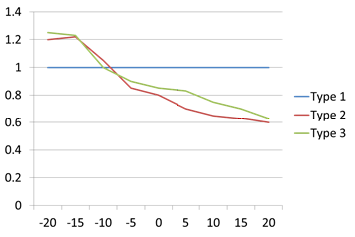Factor-controlled cooling
Information on average cooling over the period to which the information applies (normally one year) is stored for the customer in the customer data register. The function “Factor-controlled cooling” means that when power and cooling are summed from customer data to the nodes in the model, a temperature is specified as a parameter. The temperature specified is the outdoor temperature for the current load case. Every subscriber is allocated a type which corresponds to a type curve. This type curve specifies for different outdoor temperatures the factor by which the annual average cooling has to be corrected in order to attain the normal cooling in this operating case. See the example in the diagram below.

The program which sums the load from customer data interpolates/extrapolates from the curve the factor applicable to every type for the temperature specified as a parameter on summing.
We assume that the customer type, viewed from this angle, will not be registered previously in the customer database. Therefore, every customer must be assigned customer type 1 on import. This customer typ 1 is a linear curve with the factor value set to 1.0 and is predefined in the table.
 Factor-controlled return temperature
Factor-controlled return temperature